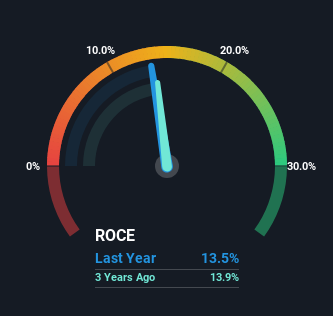- India
- /
- Telecom Services and Carriers
- /
- NSEI:RAILTEL
RailTel Corporation of India (NSE:RAILTEL) Is Experiencing Growth In Returns On Capital

If we want to find a potential multi-bagger, often there are underlying trends that can provide clues. Firstly, we'd want to identify a growing return on capital employed (ROCE) and then alongside that, an ever-increasing base of capital employed. Put simply, these types of businesses are compounding machines, meaning they are continually reinvesting their earnings at ever-higher rates of return. So on that note, RailTel Corporation of India (NSE:RAILTEL) looks quite promising in regards to its trends of return on capital.
Understanding Return On Capital Employed (ROCE)
If you haven't worked with ROCE before, it measures the 'return' (pre-tax profit) a company generates from capital employed in its business. To calculate this metric for RailTel Corporation of India, this is the formula:
Return on Capital Employed = Earnings Before Interest and Tax (EBIT) ÷ (Total Assets - Current Liabilities)
0.14 = ₹2.6b ÷ (₹36b - ₹17b) (Based on the trailing twelve months to September 2023).
So, RailTel Corporation of India has an ROCE of 14%. That's a relatively normal return on capital, and it's around the 15% generated by the Telecom industry.
Check out our latest analysis for RailTel Corporation of India

In the above chart we have measured RailTel Corporation of India's prior ROCE against its prior performance, but the future is arguably more important. If you'd like to see what analysts are forecasting going forward, you should check out our free report for RailTel Corporation of India.
What Can We Tell From RailTel Corporation of India's ROCE Trend?
The trends we've noticed at RailTel Corporation of India are quite reassuring. The data shows that returns on capital have increased substantially over the last five years to 14%. The company is effectively making more money per dollar of capital used, and it's worth noting that the amount of capital has increased too, by 26%. So we're very much inspired by what we're seeing at RailTel Corporation of India thanks to its ability to profitably reinvest capital.
For the record though, there was a noticeable increase in the company's current liabilities over the period, so we would attribute some of the ROCE growth to that. The current liabilities has increased to 47% of total assets, so the business is now more funded by the likes of its suppliers or short-term creditors. Given it's pretty high ratio, we'd remind investors that having current liabilities at those levels can bring about some risks in certain businesses.
In Conclusion...
All in all, it's terrific to see that RailTel Corporation of India is reaping the rewards from prior investments and is growing its capital base. And with the stock having performed exceptionally well over the last year, these patterns are being accounted for by investors. With that being said, we still think the promising fundamentals mean the company deserves some further due diligence.
RailTel Corporation of India does have some risks though, and we've spotted 2 warning signs for RailTel Corporation of India that you might be interested in.
While RailTel Corporation of India isn't earning the highest return, check out this free list of companies that are earning high returns on equity with solid balance sheets.
New: AI Stock Screener & Alerts
Our new AI Stock Screener scans the market every day to uncover opportunities.
• Dividend Powerhouses (3%+ Yield)
• Undervalued Small Caps with Insider Buying
• High growth Tech and AI Companies
Or build your own from over 50 metrics.
Have feedback on this article? Concerned about the content? Get in touch with us directly. Alternatively, email editorial-team (at) simplywallst.com.
This article by Simply Wall St is general in nature. We provide commentary based on historical data and analyst forecasts only using an unbiased methodology and our articles are not intended to be financial advice. It does not constitute a recommendation to buy or sell any stock, and does not take account of your objectives, or your financial situation. We aim to bring you long-term focused analysis driven by fundamental data. Note that our analysis may not factor in the latest price-sensitive company announcements or qualitative material. Simply Wall St has no position in any stocks mentioned.
About NSEI:RAILTEL
RailTel Corporation of India
Provides broadband telecom and multimedia networks and services in India and internationally.
Flawless balance sheet with reasonable growth potential.
Similar Companies
Market Insights
Community Narratives



